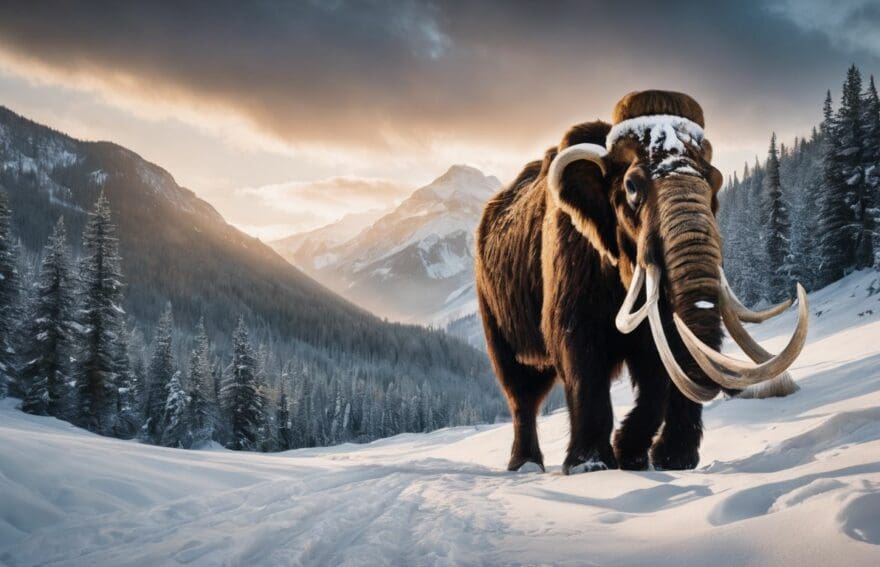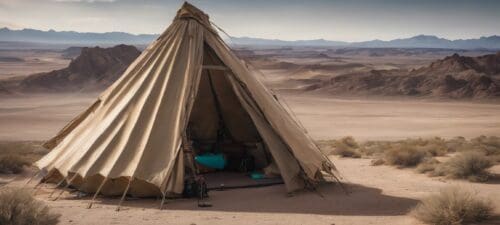Syberia: A Quest for Extinct Mammoths

Updated On: December 10, 2025 by 
Embarking on a sojourn into the boundless wilds of Siberia, our souls can’t help but be ensnared by its timeless enigmas – much like your own no doubt. The notion that extinct mammoths could once again tread upon this frosty terrain is not only fascinating; it’s tantalisingly within reach.
Research suggests their disappearance may have sparked an increase in wildfires across these parts. Our article ventures boldly into this intriguing crossroads of science and ancient marvels, shining a light on the audacious initiatives to resurrect these noble beasts from the annals of time.
Ready yourself for an enthralling escapade through eras and genetic wonders – do read on!
The History of Mammoths in Siberia
The history of mammoths in Siberia dates back to the Pleistocene era, where these magnificent creatures roamed the frozen tundra. The last mammoths in Siberia were descendants of American species that crossed over from Alaska during the Ice Age.
The last mammoths in Siberia were American
Surprisingly, the final woolly mammoths that wandered Siberia hailed from across the Bering Strait. Their ancestors roamed North America before making this stretch of icy wilderness their home.
These ancient creatures adapted to Siberian life, surviving long after others had vanished in a world dominated by ice and fierce winds.
Our understanding hinges on genetic research that unveils these mammoths’ origin stories, revealing connections between extinct species across continents. Scientists pore over DNA samples extracted from remains preserved in permafrost, piecing together a tale of migration and survival in Earth’s prehistoric chapter.
It’s a narrative etched into the very marrow of their colossal bones, offering clues about how they thrived as American immigrants in Syberia’s unforgiving landscape until their eventual disappearance.
The Quest for De-Extinction
The quest for bringing back the extinct mammoths in Siberia involves a fascinating exploration of the site of Duvanii Yar, where efforts are being made to revive these ancient creatures and restore the prehistoric ecosystem.
To learn more about this incredible journey towards reviving extinct mammoths, keep reading!
Site of Duvanii Yar
The site of Duvanii Yar in Siberia has attracted international attention due to its significant role in the study and potential resurrection of woolly mammoths. The permafrost in this region has preserved mammoth remains, providing researchers with invaluable genetic material for de-extinction efforts.
As permafrost thaws in Yakutia, scientists are making groundbreaking discoveries at this site, shedding light on the prehistoric ecosystem and paving the way for potential rewilding projects aimed at reviving extinct creatures such as mammoths.
The park situated near Duvanii Yar is envisioned as a future habitat for these majestic ancient animals, contributing to wildlife conservation efforts and offering a glimpse into the fascinating world of prehistoric mammals.
The Park: Bringing Back Woolly Mammoths
The efforts to bring back woolly mammoths are centered around a project called “The Park”. This ambitious project, spearheaded by Colossal, aims to reintroduce thousands of woolly mammoths back into their natural habitat in Siberia.
Led by Harvard geneticist George Church and with significant private funding, The Park signifies the intersection of cutting-edge genetic technology and environmental conservation.
Researchers believe that repopulating the Arctic tundra with woolly mammoths could help restore the balance of its fragile ecosystem. By reviving these ancient creatures, scientists hope to mitigate permafrost melting and decrease the frequency of wildfires in the region.
The Science Behind Reviving Mammoths
Mapping mammoth DNA has allowed scientists to understand the genetic makeup of these ancient creatures and work towards bringing them back to life. To learn more about the exciting advancements in mammoth de-extinction, keep reading!
Mapping Mammoth DNA
Scientists are mapping mammoth DNA to better understand the genetic makeup of these ancient creatures. This process involves studying the complete set of genes in a woolly mammoth’s DNA, which provides valuable insights into their physical traits and biological processes.
By examining the genetic code, researchers hope to identify specific traits that could be linked to their extinction and potentially uncover clues about adaptations needed for reintroduction into modern ecosystems.
The mapping of mammoth DNA is a crucial step in the de-extinction efforts and offers a fascinating look into the genetic legacy of these magnificent creatures.
The complex task of mapping mammoth DNA has revealed remarkable information about their genetic structure, shedding light on significant aspects such as evolutionary history and potential adaptation strategies.
Genetic Rescue of Endangered and Extinct Species
Mapping mammoth DNA allows scientists to understand the genetic makeup of these ancient creatures. The work involves identifying specific genes that can help in reviving not only mammoths but also other endangered and extinct species.
Harvard geneticist George Church leads groundbreaking efforts to apply this knowledge in de-extinction projects, aiming to restore ecological balance and biodiversity. This research is a significant step towards preserving Earth’s natural heritage.
The project aims to bring back thousands of woolly mammoths, leveraging private funding for this innovative conservation endeavor. By introducing these majestic creatures into their native habitat in Siberia, scientists hope to restore the delicate balance of the ecosystem while addressing challenges like permafrost thawing and increased wildfires caused by the absence of mammoths.
The Impact of Bringing Back Mammoths
Reviving mammoths can have a positive impact on the Arctic ecosystem by restoring the Mammoth Steppe and helping to combat climate change. Read more about the fascinating quest to bring back these ancient creatures!
Arctic Rewilding
Restoring the Arctic ecosystem through rewilding aims to reintroduce extinct animals, like woolly mammoths, to their natural habitat. This process has the potential to revive the ancient mammoth steppe and mitigate climate change by restoring the permafrost in Siberia.
Bringing back these megafauna species could help prevent wildfires and preserve the delicate balance of the Siberian wildlife.
Reviving these prehistoric creatures also holds promise for scientific research on paleontology and understanding ancient animal species’ impact on their ecosystems. The Arctic rewilding initiative not only revives extinct animals but also offers a unique opportunity to protect and understand our planet’s rich biodiversity.
Restoring the Arctic Permafrost
The thawing of permafrost in Yakutia, Siberia has attracted international attention as scientists and researchers explore the potential impacts of this phenomenon. Mammoth remains found in the region have provided crucial insights into ancient ecosystems and climate conditions.
Permafrost serves as a natural freezer, preserving organic matter including mammoth carcasses for thousands of years, thus allowing scientists to study extinct species like the woolly mammoth.
As permafrost thaws at an alarming rate due to climate change, there are concerns about releasing greenhouse gases stored within it. This could potentially exacerbate global warming by releasing massive amounts of carbon dioxide and methane into the atmosphere.
Efforts to study and understand permafrost continue to attract scientific interest from around the globe. Researchers are exploring methods for mitigating its thawing while investigating ways to harness its rich biological and historical resources for environmental insights and potential biotechnological applications.
Conclusion
In conclusion, efforts to bring back woolly mammoths are gaining momentum in Siberia. Scientists are mapping mammoth DNA and working on genetic rescue techniques. The impact of reviving mammoths could potentially help restore the Arctic permafrost and aid in arctic rewilding.
The quest for extinct mammoths is an exciting venture that could reshape the Siberian ecosystem for years to come.
FAQs
1. What is “Syberia: A Quest for Extinct Mammoths” about?
“Syberia: A Quest for Extinct Mammoths” explores the ambitious deextinction project aimed at reviving extinct species, particularly the mammoth, in the Siberian ecosystem.
2. Can scientists really bring back mammoths from extinction?
Deextinction efforts are underway to resurrect ancient species like the mammoth using advanced Arctic exploration techniques and genetic science.
3. Why do scientists want to revive an extinct species such as the mammoth?
Scientists believe that reviving extinct species can help restore balance to ecosystems and provide insights into ancient life forms and their environments.
4. Will a mammoth resurrection impact today’s Siberian ecosystem?
The introduction of revived species like the mammoth could potentially reshape the modern Siberian ecosystem by mimicking historical environmental roles they once played.









